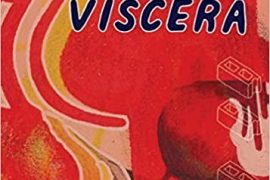A Review of The Dream of Reason (Copper Canyon) by Jenny George
The Dream of Reason’s opening poem, “Origins of Violence,” recounts a narrative of violence and horror with the gentleness of telling a story to a child.
There is a hole.
In the hole is everything
people will do
to each other.
The hole goes down and down.
It has many rooms
like graves and like graves
they are all connected.
Running like a current through Jenny George’s debut collection is the recognition that poetry does not need to name specific trauma to speak of it. “Origins of Violence,” from its first stanza, both alludes to and withholds violence. Without naming acts of good or evil, the poem opens a hole and lets all human acts fall in. This metaphorical hole contains “many rooms,” and the poem includes an Emily Dickinson nod in the simile “rooms / like graves.” The presence and connectedness brought to the poem through the image of graves troubles the materialist knowledge that graveyards are empty and the dead no more—matter is not all there is, the hole claims. Other elements trouble the characterization of the hole, some which are decorative (“Roots hang from the dirt / in craggy chandeliers” and the presence of “ballrooms”) and some animal and womb-like in their comfort (“It’s warm and dark down there”). Although the air evocatively smells “of iron and crushed flowers,” the hole is humanity’s collective failure. The closing stanzas read,
People will do anything.
They will cut the hands off children.
Children will do anything—
In the hole is everything.
No one escapes the hole, and in this way the hole is democratic and its contents familiar to all readers. But what makes the hole a powerful and deep image is both its negative capability—everything is in it—and the narrative argument proposed by the poem’s title, “Origins of Violence.” In the poem’s last four lines, we see a simultaneous naming and escaping in the descriptors “anything” and “everything” that provide a conceptual tension with other poems in the book that examine violence, trauma, and witness, such as “The Traveling Line,” a mirror-poem of pig slaughtering, “Ears” or “The Belt.” Whether the speaker of the poems stays close to an object, such as the pig in “The Sleeping Pig” or the child in “Death of a Child,” or goes beyond the object of the poem, the speaking voice is one of quiet control and wonder.
Trauma is as present as fields, dreams, houses, children, and pigs in The Dream of Reason—stepping sideways into the poem’s logic, as in “Rehearsal” (“I almost forgot what shame is / the birds coming down from the trees onto the wet, releasing earth”) or written into the landscape and natural forces, as in the lines from “Threshold”: “Summer is ending. The orchard is carved with the names of girls. / Wind fingers the leaves softly, like torn clothes.” Violence has happened—the reader knows it, feels it in everything. In George’s second of two poems titled “Spring,” the opening lines attest to the narrative presence of violence: “A devastation has occurred. Does it matter / what it was? Who commanded it?” The speaker, long ago it seems, has already told readers what has happened: everything that people do to each other.
This universalizing of human actions is echoed in another surprising way throughout the book: liturgical time, which we know as holidays (“holy days”) or feast days. While it is possible to lay aside the collection’s sacred time markers in lieu of the poems’ other explorations, dreamt or otherwise, in rereading the poems’ narrative arc one begins to see and feel the way the poems “First Day of Lent” and “Easter” introduce forty days of Lenten time between section II and section III. While section I explores iconic phenomena through a naming of abstract concepts—violence, spring, love and death—section II contains poems exploring sameness and difference among animals, with an emphasis on the subject of pigs and children. These poems, where George concentrates her wonder of life and death through focus on detail and logical claims (“When a pig dies, it is either mourned by other pigs or not”), feel like they exist in an ordinary, non-sacred time. But there is a holiness to the way George examines, for example, a dead pig’s ear, that asks us to reexamine our relationship to every living thing:
One ear folded like a lily
under the ample head,
pressed nearly in half,
silent origami.
Even while it marks a specific day on the Western church calendar, the poem “First Day of Lent” continues a thread of sacredness running through The Dream of Reason: “You make room for the silence / and so it fills you, comes in like the sea / through a great door.” Biblical images—the doors of the sea and the jars of snow in the Book of Job—echo in “First Day of Lent.” There is a cyclical, repetitious echoing of time, too, in the poem’s central couplet where the speaker narrates: “I fill the grain bucket with grain. / The water bucket with water.” The predominately end-stopped lines add to the poem’s liturgical tone, as though a bell hung at the end of each line. The calf is not buried in unmarked earth but “under the field / down where the rain is kept.” The rain and the calf are kept and tended to, both by the speaker and some other, unnamed entity.
Section III opens with the poem “New World,” telling of a world in which, “there are no slaughterhouses” and “no feedlots for fattening.” Although it might conjure the language of Revelation’s new heaven and new earth, “New World” is a neutral world and “In this great stillness,” the speaker says, “which is neither happy / nor unhappy, a fly / does his tedious business.” In the existential calm, the continuance of planetary seasons of time means little for the animal occupants, and the final three lines note: “In the morning, the sun may rise. / Who knows. / There is nothing to be longed for.”
The collection’s final poem, “Easter,” reprises The Dream of Reason’s twin investments in the natural world and the making of logical-poetic claims about that world. The poem opens with a nod to distant, received authority: “They say it is the soul that rises, not the body / But the body does rise—.” Having introduced the idea of resurrection, the speaker describes: “Overhead, in the spring wind / trees are touching each other / with quiet gestures.” In the trees’ respiration of the spring rain, the poem offers evidence that natural bodies (water, wood, air) do rise: “They have taken up / the rain and used it. / The air is fresh, smelling of wood.” “Easter” and The Dream of Reason simultaneously close on a series of questions and replies which could also be read as evoking a liturgical call and response:
What will be the first to emerge?
The brain, pushing its murderous bulb
through the mud? The heart? No—
the heart is last to rise.
The first to emerge is the image.
The brain and the heart, synecdoche for long debates in the history of philosophy over the intellect and emotions, are set aside. “No—” comes the certain reply. What follows is a response applicable to poetics as much as resurrection and trauma narratives, in that it captures both witness and vision: “The first to emerge is the image.” In closing with “Easter,” The Dream of Reason leaves its reader at a place of potential beginning with “the image”—one of the primary means by which one can navigate logical and linguistic claims in poetry. Even here, though, at the emergence of the image, the reader cannot forget “reason,” a concept introduced by the collection’s title and epigraph’s note on Francisco Goya’s etching El sueño de la razón produce monstruos. “Reason,” considered broadly, is essential to the book’s discursive form: the questioning of language and the making of questions. The exploration of “reason” is also seen in the poetic forms and craft that assist the philosophical work of George’s poetry, for example: the citation of other art (Goya’s etching, Sophocles’ Oedipus at Colonus, Vilem Flusser’s essay “The Gesture of Turning a Mask Around,” Adrienne Rich’s “Twenty-One Love Poems”) and collage (such as the livestock manual epigraphs in section II), a concern with list-making, a linking of stanzas through numbered sections and trailing enjambments, and the use of repetition and variation within and across poems. This to say: dream and reason are never far from each other in the farmscapes, orchards and slaughterhouses of The Dream of Reason. The orphic presence of George’s poems asks their reader first to read, and then to look again and attend as only philosophical, poetic, and sacred language can.
Sacred Time

0
Facebook
Twitter
Pinterest
LinkedIn
Email
More from Hannah VanderHart
Inside a Crisis: A Review of Danger Days by Catherine Pierce and Requisite by Tanya Holtland
“We are inside a crisis of planetary scale and so too is...
Read More




